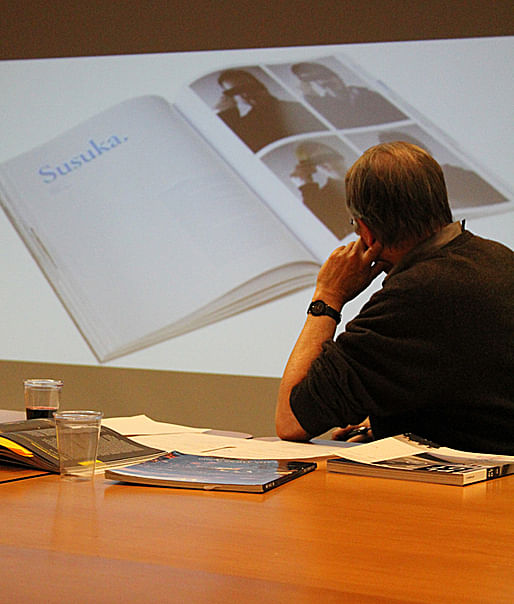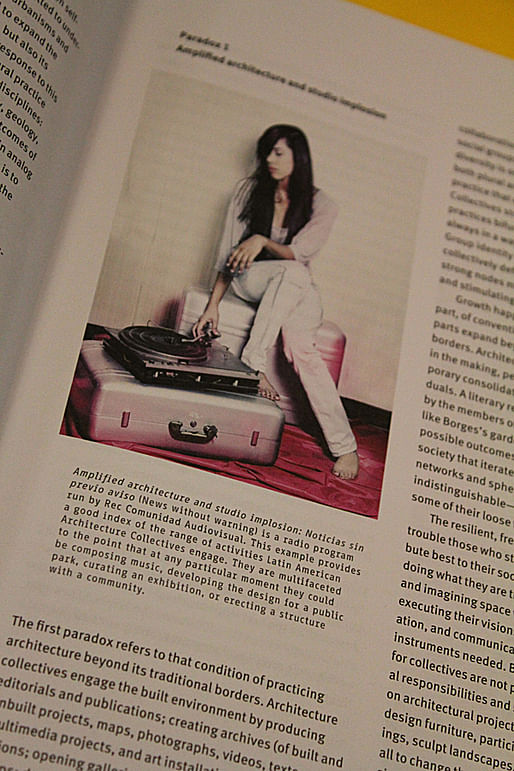
Hi Archinect!
Okay, I've been sick all week, and I've missed so very many things. (Note: if you're ever told that it's OK to get a flu shot while you have a cold without a fever, don't believe it! Flu shots are powerful.) On Monday, Asia GSD invited Erwin Lui, a senior designer at Toyota, who gave a talk called "From Concept to Reality: Tools, Technology, and Design Processes from the Automotive Industry." And on Tuesday, Tim Brown, CEO and President of IDEO talked about changes in design processes and thinking in a talk called "From Newton to Darwin: An Evolution in Design." But I was at home with a blanket up to my chin, so I didn't make it to either.
However, I am back, and tonight William Saunders, the editor of Harvard Design Magazine, and Florencia Rodriguez, editor of Plot Magazine in Argentina, are talking about their recent editorial and curatorial work related to Latin America. It's a small "roundtable discussion" with wine and cheese.
I came downstairs at 6:30pm, because the event was supposed to start at 6:30pm, and found that, of course, all the Latin Americans were drinking wine and socializing instead of taking seats. Now it is 6:55pm and people are making their way to the table.

6:58pm: Florencia Rodriguez is starting things off with a presentation. "Maybe Latin America is fashionable today, but I'd personally like to think that there's more to it than...a superficial look at things. ...There is one thing that caches my attention about editing, which is that there are many new architectural magazines in paper right now, so that the record of the present is changing very much. This democratization of information that we live with daily--Facebook, etc.--completely changes our relationship with information. And the challenge for the editor is in the way that we combine material, because the material is there for everybody. ...So you can find the same projects and photos elsewhere, but an editor is bringing together a constellation of work. And the editor's intuition [in terms of how to do this] is today more similar to that of a collage, than that of a linear process."
7:06pm: "When we chose "Plot," (as the title of our journal) we thought it was a kind of Spanglish, that everyone looks this word up in their browser at least once a day. But also it relates to a narration, and to the idea of terrain."
7:12pm: "Many questions came to mind when I was thinking about the question, "Why Latin America, why now?" One of them was Giorgio Agamben's idea of strangeness; and we South Americans often feel our strangeness in relation to (the rest of the Americas)... And with the many changes that the world is going through right now, I think there are many things about South American culture that are (relevant): our efforts to build things outside of institutions, our stubbornness..."
7:15pm: "For every issue, we take care that there is both content from South America, and content from other places; we don't want to feel like we're in the third world and have to be shy. We think these things need to work together."
"We have three main sections: the first has shorter pieces that are easily read; the second part is called "projects" and has details about work; and the third is called "theory."
"And we feel like activists. We publish, hold workshops, and try to be a very active part of our city and, we hope, of our continent."

[A spread from PLOT.]
7:20pm: William Saunders' turn.
"So my presentation will be a little different. I'll talk about how this issue came about and how it was developed; it came about because the Dean asked that we do this topic. ...And one of the first issues that came up was whether there was something wrong about doing this at all, and that question is reflected in the title: Architectures of Latin America, in the plural. Whether it was stereotyping. ...But we [guided the issue] through a number of questions that guided authors away from stereotyping. ...And an attempt to pose some general issues was made."
"And we talked, for example, about whether Brazil is part of Latin America."
7:24pm: "When we started looking at projects, we found that our urge to have things be very fresh, and look at things that hadn't been noticed much before--which is a good motive, to publish things that are really good and hadn't received much press--we realized that [many of the best projects had already been published]. ...So we found ourselves going back to projects that had been published before. But to give this more freshness and body, we had the members of our committee write short critical essays about the projects so that it wasn't just a presentation of projects."
"But we did get a sense of...often youthful architects and writers working together, often across borders, with a freshness that we aren't seeing in tired old Europe and North America these days. ...And that it was also a bit more free of the influence of [starchitect culture], so it was more innocent but also, perhaps, had more integrity."
7:30pm: Saunders is talking about a sense of the poetic that pervaded a number of projects, as well as of materiality. "These are things that we would not expect, almost ever, in our own culture in North America or in Europe. ...The fact that Latin America has moved politically to the left is also relevant, and appealing. ...Public transportation, for example, has been more robustly realized in Latin America than in North America. And the issue of limited resources is a relevant issue for our [global future, and that is something that a number of pieces touch on.]"
"I'm also aware that I'm the only one in the room keeping you from speaking in Spanish, and I apologize for that." [Laughter]

[William Saunders, editor of Harvard Design Magazine.]
7:38pm: Ana Maria Duran Calisto, a 2011 GSD Loeb Fellow, is moderating the discussion and is opening the floor. She's raising the issue of a Latin American inferiority complex, and the fact that it's only been recently that Latin American countries have felt able to compete and contribute to global discourse.
7:40pm: Comment Anita Berrizbeitia (GSD professor in Landscape Architecture): "I do think that there is a difference between how Latin America sees itself and how the United States sees itself, since the United States is a country that can [curate and pass critique on the work of other cultures]. And the references of a North American are different than those of a Latin American; there are huge cultural gaps. ...And that is why this [referring to PLOT] is so very important. ...So I think it's very important that you always include both projects from Latin America and projects from the outside--although I did notice that you always list the projects from other countries first [on the cover]."
Rodriguez: "It's just because of the order of the pages...but I'll take care of that."
7:48pm: Ana Maria Duran Calisto: "I think it would also be fascinating to look at how we construct North America from the point of view of Latin America. Latin America can even be very reactionary; it can be impervious in many ways to influences that are seen as contaminating or coming from North America. I often get [resistance] when people think that I'm introducing an Anglo-American influence."
"...And it happens that there are many [Latin American] firms that are very popular in North America, but not Latin America, but vice versa. And it was [interesting to see some of this logic at work in the editorial work at Harvard Design Magazine."
Saunders asks for examples.
Duran Calisto: "Some Latin Americans of my generation have studied in Anglo-Saxon countries and are more versed in highly technological modes of working, whereas in Latin America we more often find the poetic and literary influences that you were talking about, or even a strong functional influence."
Now there's talk about America, and how people in "Latin American" countries see themselves as Americans, not as "Latin Americans," and how we might talk about "the Americas." And just as I'm thinking that Canadians don't think of themselves as "Americans," she says, "of course, everyone forgets about Canada. Canadians hate to be called Americans because they fear becoming part of the United States."
Saunders: "You may or may not say that you have a polemic in this magazine. But even to say that you don't have a polemic is to make a polemic against polemics. So what is your polemic?"
Rodriguez: "...That we are not about the post- ...We have never been modern, as Latin Americans, but there is a new ground..."
Me: "What is the polemic of Harvard Design Magazine?"
Saunders: "We are attempting to find the best; but that begs the question of how do you define the best. When you look at something like Arquitectura Viva, or Harvard Design Magazine, there can be a preciousness in the images or attitude. And in Collectivos, there's a sense of democracy and roughness. If you look at A+U or AV, there's a celebration of the near-perfect object that could be called precious. And there's certainly a valid anti-polemic about the value of messiness."

Duran Calisto: "For example, I had to fight very hard for this image (above, with the pink). When Bill said this one was at stake, I said 'please, eliminate anything but this.' Because Latin America isn't anything if not kitsch. And the kitsch side of the culture is never discussed."
OK, I think that's a good place to sign off for now. I don't often cover small events like this, because the GSD has so many blockbuster events and those are usually the ones that I go to, but this was fun (at least, it was for me). Having never been south of Tijuana in the Americas myself, it was interesting to be in a room with so many Latin American architects, writers, and editors at once, and to find out what's on their minds.
There were several Latin American projects, authors, and firms mentioned, but I rarely caught the names because they were generally said quickly, and in a Spanish accent--but if you want to find out about these, you can check out the most recent issues of Harvard Design Magazine and PLOT!
Thanks for reading!
Lian
P.S. This event also corresponds with the South America Project: Hinterland Urbanisms Symposium ongoing now (Friday Oct 7, and Saturday Oct 8) at the GSD.
This blog was most active from 2009-2013. Writing about my experiences and life at Harvard GSD started out as a way for me to process my experiences as an M.Arch.I student, and evolved into a record of the intellectual and cultural life of the Cambridge architecture (and to a lesser extent, design/technology) community, through live-blogs. These days, I work as a data storyteller (and blogger at Littldata.com) in San Francisco, and still post here once in a while.



No Comments
Block this user
Are you sure you want to block this user and hide all related comments throughout the site?
Archinect
This is your first comment on Archinect. Your comment will be visible once approved.